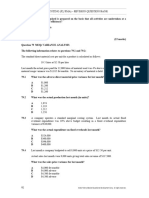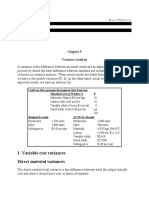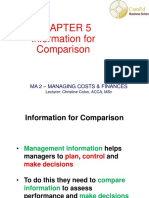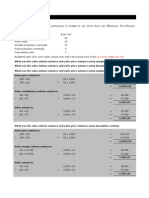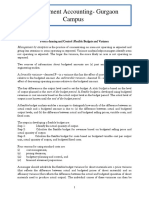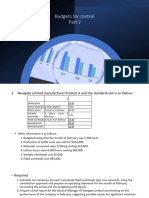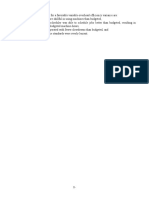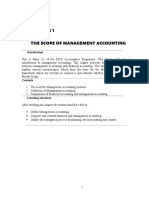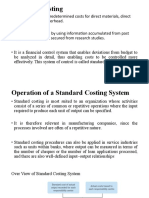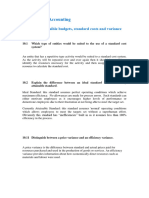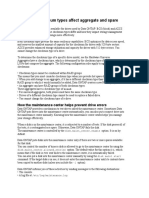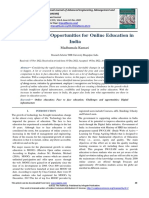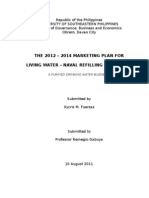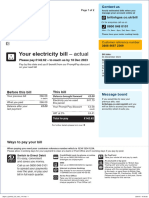REVISION QUESTION BANK – MANAGEMENT ACCOUNTING (F2/FMA) MANAGEMENT ACCOUNTING (F2/FMA) – REVISION QUESTION BANK
(c) Interrelationship between labour variances 79.5 C
$
The direct labour variance is adverse while the efficiency variance is favourable for month 1. Actual cost 144,500
This indicates some inter-dependences between the two variances. Possible reason could be Standard cost of actual production
that Matilda employed a more skilled or experienced work force who demanded a higher rate (8,500 × 15) 127,500
of pay, resulting in an adverse labour rate variance. However, the more experienced labour ––––––––
resulted in high productivity, hence a favourable efficiency variance. Total overhead variance 17,000 Adverse
––––––––
Answer 78 MCQs STANDARD COSTING 79.6 A
Item Answer Justification 79.7 D
$ Variance ($)
78.1 B (1) is a statement about absorption costing. Actual cost 110,750
4,250 F Rate
78.2 A Actual hours at standard rate (9,200 × 12·50) 115,000
5,250 A Efficiency
78.3 C Under marginal costing fixed overheads are treated as period costs and expensed Standard hours for actual production at
in the period in which they are incurred. Under absorption costing they are standard rate (2,195 × 4 × 12·50) 109,750
attributed to the cost of products (and therefore included in the valuation of
inventory). 79.8 A Price variance: $
Actual sales revenue 204,750
78.4 D Actual sales units at standard selling price (10,500 × $20) 210,000
————
78.5 A Sales price variance 5,250 A
———
78.6 B Volume variance (500 units × $20 × 0·40) 4,000 F
Answer 79 MCQs VARIANCE ANALYSIS 79.9 B Capacity variance (5,000 – 5,500) hours at $15 per hour 7,500 F
Item Answer Justification 79.10 D $
Actual hours at standard rate (27,000 × 8·50) 229,500
79.1 B Adverse price variance (0·04 × 2·50 × 12,000) = $1,200 Standard hours of production at standard rate 253,980
––––––––
79.2 C $ Therefore, labour efficiency variance 24,480 Favourable
12,000 litres at $2·50 per litre 30,000 ––––––––
Add Favourable usage variance 1,815
–––––– 79.11 A Sales price variance: $
Standard cost of actual production 31,815 Actual sales at standard price (4,650 × 6) 27,900
–––––– Actual sales at actual price 30,225
Actual production $31,815 ÷ (10·5 × 2·50) 1,212 units ––––––––
–––––– Favourable price variance 2,325
79.3 C Let x = budgeted expenditure ––––––––
1·1x – x = 36,000 Adverse sales volume contribution variance:
x = 360,000 350 units × (6 × 0·60) 1,260
1·1 x = 396,000 = actual expenditure ($)
79.12 B (Budgeted quantity – Actual quantity) × standard profit per unit
79.4 C $ (1,000 – 900) × (50 – 39) = $1,100
Actual sales at standard selling price 112,500
(9,000 × $12·50) 79.13 A Budgeted overhead – actual overhead = 1,250
Actual sales at actual selling price 117,000 Actual overhead = 0·98 × Budgeted overhead
–––––– Budgeted overhead – (0·98 × Budgeted overhead) = 1,250
Sales price variance 4,500 favourable Budgeted overhead = 1,250 ÷ 0·02 = 62,500
–––––– Actual overhead = 62,500 – 1,250 = $61,250
©2017 DeVry/Becker Educational Development Corp. All rights reserved. 1077 1078 ©2017 DeVry/Becker Educational Development Corp. All rights reserved.
� REVISION QUESTION BANK – MANAGEMENT ACCOUNTING (F2/FMA) MANAGEMENT ACCOUNTING (F2/FMA) – REVISION QUESTION BANK
79.14 B Actual production should have used 10,000 kgs (5,000 × 2). Raw material 79.29 B Fixed overhead capacity variance = (actual hours worked – original budgeted hours) ×
inventory increased by 2,000 kgs ($8,000 ÷ $4), so 11,000 kgs of the 13,000 standard rate per hour.
purchased went into production. The material usage variance is therefore $4,000
(1,000 kgs × $4). Standard rate per hour = $125,000 ÷ 25,000 hours = $5 per hour
Fixed overhead capacity variance = (26,000 – 25,000) × $5 = $5,000 favourable
79.15 D (($10,000 ÷ (20,000 – 18,000)) + $4) × (20,000 – 18,000) = $18,000 F
79.30 Actual contribution was $8,500.
79.16 A A strike will reduce operating capacity so fewer than budgeted hours will be $
worked. When an absorption costing system is used this will result in an adverse Standard contribution on actual sales 10,000
fixed overhead capacity variance. Add: Favourable sales price variance 500
Subtract: Adverse total variable costs variance (2,000)
79.17 C $57,200 – (5,200 × $50,000 ÷ 5,000 units) = $5,200 F –––––
Actual contribution 8,500
Tutorial note: This is a relatively rare example of an item where common sense –––––
leads to the correct answer. As only option A is adverse this is most likely to be a
distracter. Therefore, of the 3 favourable options, the one which matches the 79.31 Actual contribution for last month was $41,000.
adverse option is most likely to be correct! $
Standard contribution on actual sales 40,000
79.18 A (5,200 units – 5,000 units) × $20,000 ÷ 5,000 units = $800 F Add: Favourable sales price variance 1,000
–––––
79.19 A (6,000 units – 5,000 units) × $25,000 ÷ 5,000 units = $5,000 Actual contribution 41,000
–––––
79.20 A ((100,000 units × 2 hours) – 205,000 hours) × $12 = $60,000 A 79.32 Actual contribution last month was $22,000.
79.21 C ($12 – $13) × 205,000 hours = $205,000 A The fixed overhead expenditure variance is not relevant to a reconciliation of
budgeted and actual contributions. Therefore actual contribution = (20,000 – 3,000
79.22 C Labour efficiency relates to work done in hours which are paid for. + 5,000) = $22,000.
79.23 C If the exchange rates for imported materials increases the cost is reduced. 79.33 A Tutorial note: The answer can be obtained by “working backwards” from the
actual profit figure. Because we are working backwards, adverse variances must be
79.24 B added back and favourable variances must be deducted to get to the budgeted profit
figure. Fixed production overhead capacity and efficiency variances are sub-
79.25 B divisions of the fixed production overhead volume variance.
79.26 A If the total materials variance is favourable this could be due to a favourable $000
materials price variance and/or a favourable materials usage variance. These in turn Actual profit 500
could be caused by: Add
Sales volume profit variance 10 adverse
(1) A fall in direct material prices Direct labour efficiency variance 15 adverse
(2) A fall in raw material usage per unit Fixed production overhead volume variance 10 adverse
Less: Fixed production overhead expenditure 50 favourable
Tutorial note: Factors (3) and (4) would not affect the materials variances since ––––
materials variances are based on actual production not budgeted. Budgeted profit 485
––––
79.27 Original budgeted profit for the period was $140,000.
$ 79.34 A The correct answer can be arrived at by looking for a combination of variances that
Original budgeted profit (balancing figure) 140,000 satisfy two criteria:
Sales volume variance (25,000)
––––––– (i) The total of the variances must add to $5,000 adverse as actual profit is
Standard profit on actual sales 115,000 $5,000 less than budgeted profit.
–––––––
(ii) As budgeted profit was $30,000 ($25,000 actual plus a $5,000 adverse
79.28 A Standard rate per hour = $125,000 ÷ 25,000hours = $5 per hour total variance) and standard profit on Actual sales is $15,000 (given) then
(27,000 – 24,000) × $5 = $15,000 favourable the sales volume variance must be $15,000 adverse.
Only alternative A meets both of these criteria.
©2017 DeVry/Becker Educational Development Corp. All rights reserved. 1079 1080 ©2017 DeVry/Becker Educational Development Corp. All rights reserved.
� REVISION QUESTION BANK – MANAGEMENT ACCOUNTING (F2/FMA) MANAGEMENT ACCOUNTING (F2/FMA) – REVISION QUESTION BANK
79.35 Actual contribution for the month was $46,500. 79.39 D $
$ Actual profit 27,000
Standard contribution on actual sales 50,000 Add
Subtract: Adverse total variable costs variance (3,500) Sales price variance 5,000 adverse
–––––– Less
Actual contribution 46,500 Fixed overhead volume variance (3,000) favourable
–––––– ––––––
Budgeted profit 29,000
Tutorial note: No adjustment is required for the favourable sales volume
––––––
contribution variance as it will have been added already to the budgeted
contribution to arrive at the standard contribution from actual sales. The total fixed Tutorial note: To work “back” to budgeted profit from actual profit it is necessary
costs variance does not affect contribution. to:
79.36 C In an absorption costing system the sales volume variance is valued at standard (i) Add back adverse variances; and
profit per unit, whereas under a marginal costing system it is valued at standard
contribution per unit. In an absorption costing system the total fixed overhead (ii) Deduct favourable variances.
variance includes fixed overhead expenditure and fixed overhead volume variances.
Under marginal costing only the expenditure variance is included. Variable cost Remember also that the fixed overhead volume variance ($3,000F) is equal to the
variances are the same under both systems. sum of the fixed overhead capacity variance ($4,000 F) and the fixed overhead
efficiency variance ($1,000 A), so not all variances will appear in the reconciliation
79.37 A (otherwise there will be double counting).
$000
Actual profit 500 79.40 A This is calculated by finding the balancing figure:
Add $
Sales volume profit variance 10 adverse Total variance in contribution ($20,000 – $15,000) 5,000 adverse.
Direct labour efficiency variance 15 adverse Sales volume and sales price variances 4,000 favourable
Fixed production overhead volume variance 10 adverse ––––––
Less Variable cost variance 9,000 adverse
Fixed production overhead expenditure 50 favourable ––––––
–––
Budgeted profit 485 Answer 80 CARTER
–––
(a) (i) Net present value
Tutorial note: When budgeted profit is reconciled to actual profit (e.g. in an
operating statement), favourable variances are added and adverse variances are Time Cash flow 10% factor Present value
deducted. So when working “backwards” from actual profit to budgeted profit, $ $
adverse variances must be added back and favourable variances must be deducted. 0 (32,000) 1 (32,000)
Remember also that the fixed production overhead capacity and efficiency 1 – 15 5,000 7.606 38,030
variances are components of the fixed production overhead volume variance. So ———
only the volume variance or its components are included in the reconciliation, Positive NPV 6,030
otherwise there will be an error (double counting). ———
79.38 A The correct combination of variances must satisfy two criteria: In view of the positive NPV the project should be undertaken.
(1) The total must add to $5,000 adverse as actual profit is $5,000 less than Provided the company has no serious cash flow problems (in which case one could
budgeted profit; be swayed by the long payback period) the NPV calculations should be used to
evaluate net projects.
(2) As budgeted profit is $30,000 ($25,000 actual + $5,000 adverse variance)
and standard profit on actual sales is $15,000 (given) the sales volume
variance must be $15,000 adverse.
©2017 DeVry/Becker Educational Development Corp. All rights reserved. 1081 1082 ©2017 DeVry/Becker Educational Development Corp. All rights reserved.
